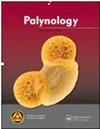Palynotaxonomy of the subtribe Anisopappinae (Athroismeae, Asteraceae) and the genus Duhaldea (Inuleae, Asteraceae) based on their exine ultrastructure
IF 1.3
4区 地球科学
Q3 PALEONTOLOGY
引用次数: 0
Abstract
AbstractThe exine ultrastructure of eighteen species of Anisopappus (Anisopappinae, Athroismeae, Asteraceae) and three species of Duhaldea (Inuleae, Asteraceae) was studied using Transmission Electron Microscopy (TEM). Two ultrastructural patterns were identified: Senecioid and Helianthoid. The Senecioid pattern is characteristic of the species included in the basal clades of the phylogenetic tree of Anisopappus, as published in earlier studies. The Helianthoid pattern is restricted to the taxa placed in the derived clades, including the core group of species of Anisopappus where A. chinensis, the type species, is included. The observed ultrastructural differences seem to suggest that a future splitting of Anisopappus into several different genera should not be disregarded and that the Helianthoid pattern represents, within this genus, the derived condition. The ultrastructure of the exine supports the inclusion, suggested by previous authors, of the species Duhaldea stuhlmannii, but not that of Philyrophyllum schinzii, in Anisopappus. In contrast, the three studied species of Duhaldea (D. cappa, D. nervosa, D. revoluta) present an exine with a Senecioid pattern, which is characteristic of the tribe Inuleae, in which they are included. The ectoaperture, mesoaperture, and endoaperture of all studied Anisopappinae and of Duhaldea, respectively intersect the tectum plus columellae, the foot layer and the outer part of the endexine, and the inner part of the endexine. This feature seems to characterize, in a consistent way, the “Heliantheae alliance”, and is also present in all the studied Asteroideae (excl. Anthemideae), Dicomoideae, and Carduoideae.Keywords: AnisopappusAnisopappinaeDuhaldeaexinemesoaperturespalynotaxonomyultrastructureDisclaimerAs a service to authors and researchers we are providing this version of an accepted manuscript (AM). Copyediting, typesetting, and review of the resulting proofs will be undertaken on this manuscript before final publication of the Version of Record (VoR). During production and pre-press, errors may be discovered which could affect the content, and all legal disclaimers that apply to the journal relate to these versions also.基于外叶超微结构的山葵亚族(蕨目,菊科)和杜鹃属(茵叶目,菊科)孢粉分类
摘要利用透射电子显微镜(TEM)研究了18种异角蕨科(异角蕨科,刺尾蕨科)和3种杜鹃科(刺尾蕨科,菊科)的外壁超微结构。发现两种超微结构模式:Senecioid和Helianthoid。在早期的研究中发表的研究结果表明,Senecioid模式是异角猿系统发育树的基础分支中包含的物种的特征。Helianthoid模式仅限于被置于衍生枝中的分类群,包括以模式种中国古猿(A. chinensis)为代表的异距鸟(Anisopappus)核心类群。观察到的超微结构差异似乎表明,不应忽视未来异角猿分裂为几个不同属的可能性,而在这个属中,Helianthoid模式代表了衍生的条件。外壁的超微结构支持了先前作者提出的物种Duhaldea stuhlmannii的包含,而不是Philyrophyllum schinzii的包含。相比之下,所研究的Duhaldea (D. cappa, D. nervosa, D. revoluta)的三个种呈现出具有Senecioid模式的外壁,这是Inuleae部落的特征,它们被包括在其中。所研究的异松科和杜哈尔亚科的外孔、中孔和内孔分别相交于顶盖加小柱、足部与叶尖外侧和叶尖内侧。这一特征似乎是“Heliantheae联盟”的一贯特征,也存在于所有研究的Asteroideae(不包括Anthemideae)、Dicomoideae和Carduoideae中。关键词:异角蝶,异角蝶,duhaldeexineme, esoaperture, respalyno, taxonomy,超微结构免责声明作为对作者和研究人员的服务,我们提供这个版本的接受稿件(AM)。在最终出版版本记录(VoR)之前,将对该手稿进行编辑、排版和审查。在制作和印前,可能会发现可能影响内容的错误,所有适用于期刊的法律免责声明也与这些版本有关。
本文章由计算机程序翻译,如有差异,请以英文原文为准。
求助全文
约1分钟内获得全文
求助全文
来源期刊

Palynology
地学-古生物学
CiteScore
3.40
自引率
26.70%
发文量
48
审稿时长
>12 weeks
期刊介绍:
Palynology is an international journal, and covers all aspects of the science. We accept papers on both pre-Quaternary and Quaternary palynology and palaeobotany. Contributions on novel uses of palynology, review articles, book reviews, taxonomic studies and papers on methodology are all actively encouraged.
 求助内容:
求助内容: 应助结果提醒方式:
应助结果提醒方式:


